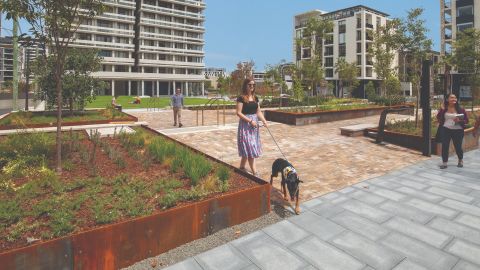Dyuralya Square, at the intersection of Amelia and Murray streets, Waterloo, is a new 2,000 square metre community meeting place for small events, markets and performances. The area has a rich natural and social history.
Vast wetlands and abundant wildlife
Dyuralya Square, alongside Green Square, was once part of Australia’s extensive Lachlan and Waterloo wetland system. Natural aquifers created a network of freshwater creeks and wetlands that flowed into the Cooks River and Botany Bay. Mangroves and saltmarsh flourished around the estuary mouth. The creeks wended through sand dunes, covered by heath and scrub.

Dyuralya means ‘brolga’ in the Sydney Aboriginal language. The wetlands echoed with a cacophony of bird calls - red bills, water hens, ducks, bronze-winged pigeons, brolga and black swans. There were fish and eels in the clear creeks. Brush wallabies, bandicoots, possums and even emus once thrived in the area. The wetlands provided sustenance for Aboriginal peoples for thousands of years.

The first colonial industries at Waterloo Swamp
In the early 1800s, the area’s plentiful water supply started to attract local manufacturers searching for power sources for their mills. The first colonial industries were established south of Dyuralya Square on the banks of Waterloo Swamp and across to the east on the Lachlan Swamp. Grain and cloth mills appeared from the 1810s and the first wool wash in the 1820s. From the 1850s, noxious trades were pushed out from the city and they gravitated to the abundant water supply of the Waterloo Swamp. The area became home to wool washes, tanneries, boiling
down works, candle and soap-making works.
Market gardens and breweries
The freshwater creeks also irrigated breweries and market gardens. The alluvial soils made for productive market gardens - Waterloo, Alexandria and Botany became a key vegetable producing area for the city. Two street names honour Chinese market gardeners who worked in this precinct in the 1880s and 1890s. Tung Hop was identified in the Sands’ Directories as working gardens in this block 1891-1893. Sam Sing was a Chinese gardener who worked on this site in 1888.
By the mid 19th century, brickworks, glassworks and a pottery works were also thriving. The noxious trades gradually dammed and polluted the wetlands, turning it into a big industrial drainage system, and forever transforming Shea’s Creek. The Waterloo Swamp was drained and reclaimed in 1908 to create Victoria Park Racecourse.
The age of Akubra
By the early 20th century, Waterloo was transformed from a small fringe suburb to a major industrial and manufacturing district where Akubra hats were made. So too were Chubb safes, Wormald fire-fighting appliances and Crown Crystal cut-glass vases.
The south Sydney area became an industrial powerhouse in the 1920s attracting thousands of workers. In the post-war period, Greek, Italian, Lebanese, Ukrainian and Vietnamese migrants found jobs in the factories.
Hat maker Benjamin Dunkerley revolutionised the industry by patenting a machine for dressing rabbit fur. He allegedly named the Akubra after the Aboriginal word for ‘head covering.’ After being contracted to supply slouch hats to World War I diggers, Dunkerley never looked back. Dunkerley Hat Mills moved from a cramped factory in Surry Hills to brand new premises on Bourke Street in 1919 where it manufactured hats until 1972. Its manufacturing history is commemorated in the street name Dunkerley Place.

Reed Paper Products

Reed Paper Products became Australia’s largest manufacturer of paper products. Its 2 factories, on nearby Amelia Street and in Redfern, covered 13 acres and employed 600 people by 1938. It produced hatboxes, shoeboxes, playing cards, including the Mystic brand, and cardboard packaging. The factory closed in the late 1970s.

This factory’s history is recognised through surrounding street names, including Mystic, Reed, and Hatbox.
Published 21 March 2019, updated 1 April 2019


